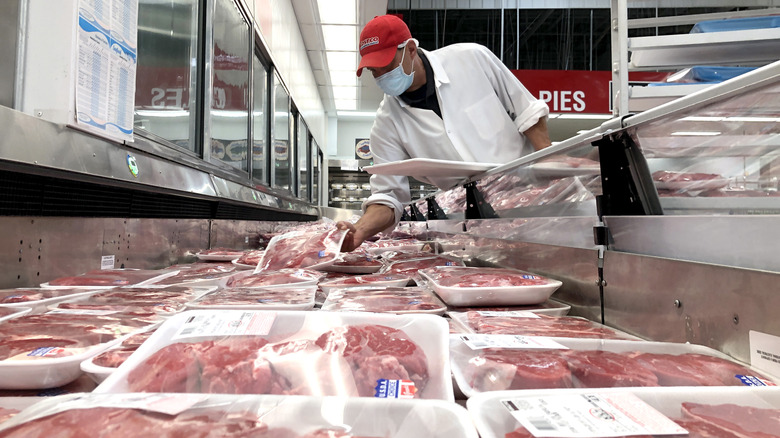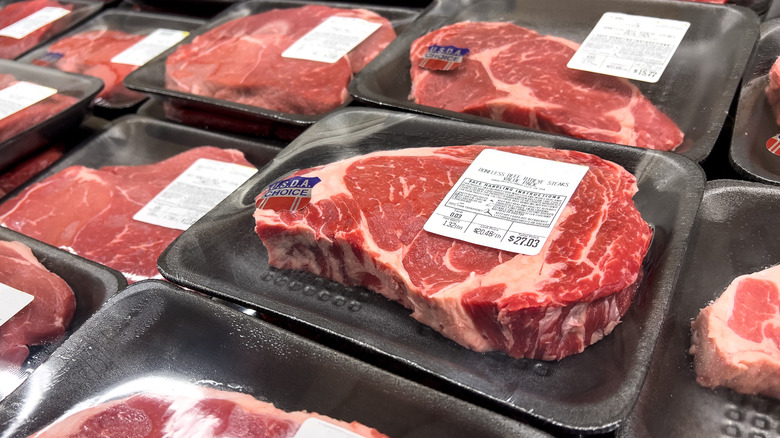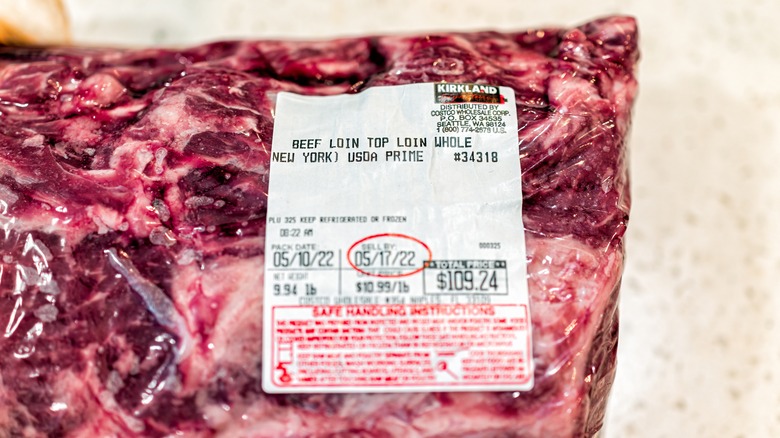Why You Should Think Twice Before Buying Costco's Steaks
Steaks, like sauces, come in nearly endless varieties. From versatile rib cuts — Anthony Bourdain's favorite – to the delicate filet mignon, steaks can offer the adventurous eater a plethora of enjoyable meals, and all these different cuts of steak come from the same bovine cloth. But before home cooks sit down with their next steak au poivre, they should be wary of one processing method used by Costco, which could turn many potential eaters away from styrofoam-packaged cuts of beef.
The labels on steaks from Costco and other carriers might read "blade tenderized," which sounds harmless enough. However, this tenderizing process entails a higher likelihood of bacterial contamination from the outside of the meat into the inside. In turn, officials from the U.S. Department of Agriculture recommend cooking the steaks to a higher internal temperature — to at least 145 degrees Fahrenheit with a three-minute rest included — to offset the risk of disease. Since 145 degrees is the upper limit for medium steak doneness, this tenderization method makes it more difficult for cooks to safely enjoy rare or even medium rare steaks from Costco.
How blade tenderization affects your steak
The overall tenderness of a steak is usually determined by how much connective tissue that cut of beef contains – coupled with its fat content and how it's cooked. To make tough cuts more succulent, they sometimes undergo mechanical tenderization. With blade tenderization, blades or needles pierce holes in the beef during processing to break down that connective tissue and create a more melt-in-your-mouth cut. The downside is that if bacteria (such as salmonella or E. coli) are present on the surface of the beef during processing, they can easily make their way to the meat itself. These bacteria live inside the animals' organs and can contaminate the meat if something like manure comes into contact with the beef during slaughter.
Because the inside of any given steak takes longer to cook than the outside — as any grillmaster or stainless steel warrior knows — potential disease-causing bacteria have a better chance of surviving the cooking process there. Hence, the USDA will often add a recommended cooking temperature to the steak packaging if the product indicates blade tenderizing.
Not all steaks are mechanically tenderized
Let's not malign the Costco-goers: They're onto something. Pushing a shopping cart the size of a small sedan along aisles as wide as a neighborhood street and perusing bulk wares that'll last you two weeks while consuming samples of buffalo chicken tenders and garlic bread can be a delightful experience. And even though many steaks sold at Costco have been subject to blade tenderizing and may require some extra work in order to be consumed safely, all is not lost.
Since at least 2013, Costco has been labeling their blade tenderized cuts of beef, out of an abundance of caution. If the label notes that the steak should be cooked to at least 145 degrees Fahrenheit, it can't be enjoyed rare or medium rare. If you prefer to eat your steak on the bluer side, the best way to avoid blade-tenderized beef is to read the label and avoid anything that reads "blade tenderized," "machine tenderized," or something similar.



